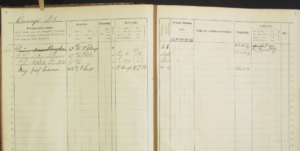Your Swedish Ancestor’s Household Examinations

Hello everyone! How has your week gone? How are you doing with your genealogy? Are you coming up against new roadblocks or have you found a “gold vein” of information? Genealogy is a fascinating area because you don’t just work on it then you’re done. It has many avenues that can take you many directions. It isn’t always easy to stay on task and that’s where self-discipline comes in.
When my brain wants me to go down a path that I didn’t plan for that day, then I just write it down in my notebook and tell my brain that I will come back to that path. I honor my plan that I made for that day and plug in the new path for another day or week. It all needs to get done, but we don’t have to do it all right now! I find pacing myself, planning my genealogy day or week, and sticking to that plan no matter what new thing comes up works really well for me. I know that the genealogy will get done and the work moves forward.
God also helps me decided what is more of a priority than another when it comes to genealogy. He is definitely involved with all that I do for genealogy.
So I felt like I needed to talk about Sweden’s Household Examination records for this week because if you find your ancestor here, then you can find them in birth, marriage, and death records from the information provided on the Household Examination records. So that’s where we’re going to be this week. So hang on and enjoy the ride!
Background
What are Household Examinations? It all began in Sweden back in the 1600’s. There was a decree that the clergy now needed to keep a record of all of their parishioners and how they were learning certain sections of their catechisms and other church rules. The clergy set up a system that they would go annually from household to household, farm to farm, and record the progress of the people in their religious duties. This included all servants and farmhands as well as the family members.
Other Scandinavian countries tried to keep these records as well, however, Sweden was the only one that continued the practice to this day. They chose to use these records in place of census records, while the other countries switched to using census records. So household examination records are unique to this country. You would use them in place of census records.
Information found on these records

I love these records because they contain so much family information! I use these records to start my search in finding the other birth, marriage, and death records that I need. Here is what’s on these records.
- Farm name
- Family members and servants names
- Birth, Marriage, Death dates, places, and ages
- Moving in or out of the parish dates
- Military information
- Years covered by the record book
- Marital status
- Deaths of children
- Pages to reference other genealogy records
How to Use these records
The basic strategy for using these records is based on having all of the church records available. Some records were destroyed by fire, wars, floods, etc. So if they are all available, then this is what you would do.
- 1. Know the farm name for your ancestor. This is crucial so take the time to find it in other church records, from family sources, Ancestry.com or FamilySearch.org, or by going page by page through the household examinations.
- 2. Find the family in the household examination records. This can be done by looking at the index for that family’s farm name, or it will be listed alphabetically, or you may have to find the family by going page by page.
- 3. Search all of the household examination records from birth to death. This is done because those records will list page and book numbers for the next household examination book. Each book usually has a five year span and then it moves on to the next book. Keep following the person until they die. That way you can see their lives and how they lived and what changed for them.
- 4. Verify the information by going to birth, marriage, and death registers. Household examination records can have the wrong information. Other church books can verify them. The info found in those church books has more value to them than what’s written on the household examination records. So if the church books have different information, then that information is to be believed over the household examination information.
Then once you have found all of the information for that family, you get to move on to the next generation and follow the same basic steps for them.
Summary
Neat, huh? Next week, I think I will go through a case study for you so that you can see all of this in action. Right now, just absorb this information and know that your Swedish ancestor can and will be found with the right tools. For more information, you can check out my articles on Swedish marriages or Swedish Place Names or how to get started with your Swedish research. In addition, there are other articles about household examination records and other Swedish records here and here. So go check it out!
As always, good luck and happy hunting!
Tiffany
ancestry.com, census records, familysearch.org, farm names, household examination records, Sweden
